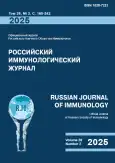CD44 expression level on different cell lines of hematopoietic origin
- 作者: Pashkina E.A.1,2, Bykova M.V.1, Berishvili M.T.2, Krugleeva O.L.2
-
隶属关系:
- Research Institute of Fundamental and Clinical Immunology
- Novosibirsk State Medical University
- 期: 卷 28, 编号 2 (2025)
- 页面: 177-180
- 栏目: SHORT COMMUNICATIONS
- URL: https://ogarev-online.ru/1028-7221/article/view/284806
- DOI: https://doi.org/10.46235/1028-7221-17053-CEL
- ID: 284806
如何引用文章
全文:
详细
CD44 is a hyaluronic acid receptor, a surface molecule expressed on many cells in human body that is essential for some processes, such as cell adhesion and migration. Therefore, this molecule also plays an important role in various aspects of tumor growth, metastasis and invasive processes. High levels of CD44 expression have been found on tumor cells from patients with hematological malignancies, and there is a direct link between CD44 levels and the likelihood of relapse, as well as a dismal prognosis in most hematological malignancies. The purpose of this study was to determine the level of CD44 expression on the surface of tumor cells, namely cell lines of hematopoietic origin.
The expression of CD44 on cell lines 1301 (T cell lymphoma) and K562 (erythromyeloid leukemia) was assessed by flow cytometry.
It was demonstrated that the both cell lines are capable of expressing the CD44 molecule on their surface. In the case of erythromyeloid leukemia cell line K562, a low level of expression of this receptor was observed, while in the case of the T cell lymphoma cell line 1301, the vast majority of cells showed high level of CD44 expression.
In general, the level of expression of this receptor on tumor cells in the case of hematological malignancies may be quite variable in different cell lines of hematopoietic origin.
作者简介
E. Pashkina
Research Institute of Fundamental and Clinical Immunology; Novosibirsk State Medical University
编辑信件的主要联系方式.
Email: eapashkina@niikim.ru
PhD (Biology), Head, Extra-Budgetary Laboratory for Regulation of the Immune Response; Associate Professor, Department of Clinical Immunology
俄罗斯联邦, Novosibirsk; NovosibirskM. Bykova
Research Institute of Fundamental and Clinical Immunology
Email: eapashkina@niikim.ru
Postgraduate Student, Junior Researcher, Laboratory for Regulation of the Immune Response
俄罗斯联邦, NovosibirskM. Berishvili
Novosibirsk State Medical University
Email: eapashkina@niikim.ru
Student
俄罗斯联邦, NovosibirskO. Krugleeva
Novosibirsk State Medical University
Email: eapashkina@niikim.ru
PhD (Medicine), Head, Department of Clinical Immunology
俄罗斯联邦, Novosibirsk参考
- Alder S., Ciampi A., McCulloch E.A. A kinetic and clonal analysis of heterogeneity in K562 cells. J. Cell. Physiol., 1984, Vol. 118, no. 2, pp. 186-192.
- Bertrand P., Courel M.N., Maingonnat C., Jardin F., Tilly H., Bastard C. Expression of HYAL2 mRNA, hyaluronan and hyaluronidase in B-cell non-Hodgkin lymphoma: relationship with tumor aggressiveness. Int. J. Cancer, 2005, Vol. 113, no. 2, pp. 207-212.
- Hertweck M.K., Erdfelder F., Kreuzer K.A. CD44 in hematological neoplasias. Ann. Hematol., 2011, Vol. 90, no. 5, pp. 493-508.
- Khan N.I., Cisterne A., Devidas M., Shuster J., Hunger S.P., Shaw P.J., Bradstock K.F., Bendall L.J. Expression of CD44, but not CD44v6, predicts relapse in children with B cell progenitor acute lymphoblastic leukemia lacking adverse or favorable genetics. Leuk. Lymphoma, 2008, Vol. 49, no. 4, pp. 710-718.
- Litzenburger U.M., Buenrostro J.D., Wu B., Shen Y., Sheffield N.C., Kathiria A., Greenleaf W.J., Chang H.Y. Single-cell epigenomic variability reveals functional cancer heterogeneity. Genome Biol., 2017, Vol. 18, no. 1, 15. doi: 10.1186/s13059-016-1133-7.
- Marques L.V.C., Noronha E.P., Andrade F.G., Dos Santos-Bueno F.V., Mansur M.B., Terra-Granado E., Pombo-de-Oliveira M.S. CD44 expression profile varies according to maturational subtypes and molecular profiles of pediatric T-cell lymphoblastic leukemia. Front. Oncol., 2018, Vol. 8, 488. doi: 10.3389/fonc.2018.00488.
- Zhu Q., Zhao X., Zhang Y., Li Y., Liu S., Han J., Sun Z., Wang C., Deng D., Wang S., Tang Y., Huang Y., Jiang S., Tian C., Chen X., Yuan Y., Li Z., Yang T., Lai T., Liu Y., Yang W., Zou X., Zhang M., Cui H., Liu C., Jin X., Hu Y., Chen A., Xu X., Li G., Hou Y., Liu L., Liu S., Fang L., Chen W., Wu L. Single cell multi-omics reveal intra-cell-line heterogeneity across human cancer cell lines. Nat. Commun., 2023, Vol. 14, 8170. doi: 10.1038/s41467-023-43991-9.
补充文件









